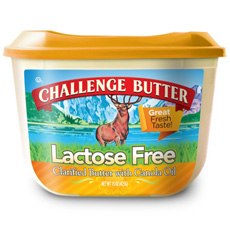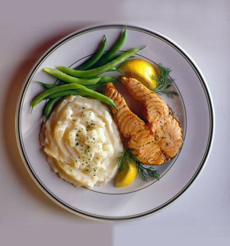PRODUCT: Challenge Lactose Free Butter
 A delicious butter spread that’s lactose free! Photo courtesy Challenge Dairy. |
An estimated 30 to 50 million Americans have lactose intolerance, a condition wherein individuals naturally lose the ability to digest lactose—the natural sugar component of milk—as they grow into adulthood. In some of the world’s populations, the condition begins in childhood, after weaning. In others, it happens on an individual basis in late middle age or beyond. Still other people never lose their ability to produce lactase, the enzyme that digests lactose. And since the inability to digest lactose continues to grow as many people age, our population has millions of contenders discovering their lactose intolerance every year. We are one of those people. Having grown up on butter, milk, cheese (cottage cheese, cream cheese, mozzarella and other fresh cheeses and lots of aged cheeses), sour cream, yogurt and ice cream, we suddenly became unable to digest them (or more accurately, they get digested with some unpleasant side effects). |
|
|
We quickly found lactose-free staples in: While no one has yet marketed a lactose-free bar of butter, Challenge Dairy now has a delicious lactose-free butter spread. The California-based maker of butter and cream cheese, representing some 600 dairy farm families, has made life easier for the lactose-intolerant. Their lactose-free spreadable butter clarifies the butter, a process that removes the milk solids that contain the lactose (this is the same process used to make clarified butter and ghee). The butter is then blended with canola oil to create a smooth, spreadable butter. The result: a buttery spread that has half the calories of regular butter. One tablespoon has 50 calories, 2 grams saturated fat (of 5.5 grams total fat) and 110 milligrams sodium. The lactose-free butter is available at retailers nationwide, including Albertsons, BI-LO, Harris Teeter, HEB, Jewel, Lucky’s, Meijer, Safeway, Savemart, Vons and Winn Dixie. A 15-ounce container is $4.49 Learn more at ChallengeDairy.com. See the foods that have hidden lactose, below. |
||
|
FACTORS THAT IMPACT THE TASTE OF BUTTER Why do different brands of butter vary in flavor? Several factors are responsible, according to Challenge Dairy. |
 Now, enjoy butter mashed potatoes to your heart’s content. Photo courtesy U.S. Potato Commission. |
|
|
Some people are just mildly lactose intolerant, others are extremely so (more information). Every person handles it differently. If you think you might be lactose intolerant, a gastroenterologist can give you the test. As with sugar and salt, there is “hidden lactose” everywhere.
|
||